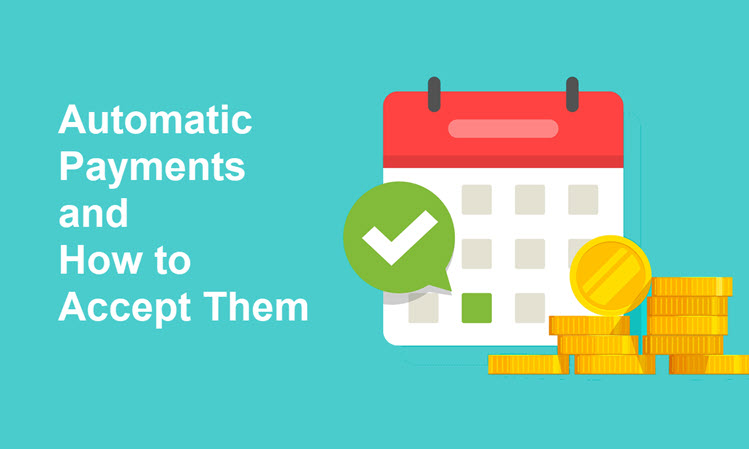Automatic payments are one of the vital features of efficient payment processing. They help ecommerce business owners optimize their business operations.
Merchants use them to allow recurring customers to automatically pay their monthly bills, memberships, subscriptions, loans, and other regular payments.
In this article, we explain what automatic payments are, how they work, and how to accept automatic payments.
What Are Automatic Payments?

An automatic payment is a transaction based on an agreement between a merchant (creditor) and a customer (user) under which the customer authorizes the creditor to withdraw a certain amount of money from the customer’s bank account or credit card.
Automatic payments help merchants collect their customers’ recurring payments without asking them to enter their payment information every time the payment is due.
There are two types of automatic payments:
- Variable Payments. In variable payments, the amount of money collected by the merchant varies, depending on the number of products and services the customer has used within the payment cycle.
- Fixed Payments. In fixed payments, the amount of money billed by the merchant is always the same.
Automatic Payment Example
Let’s say that a merchant has started a subscription business. They want to simplify payments for people who decide to subscribe to their service. If their customers need to enter their payment information every single time they make a purchase, it could negatively affect the conversion rate.
Conversely, allowing customers to sign up for automatic payments is highly likely to improve payment convenience and reduce the churn rate.
Once the customer provides the payment data and opts for automatic payments, they only need to ensure that there are enough funds on their bank account on the payment due date.
How Do Automatic Payments Work?

To start receiving automatic payments, the customer must authorize the merchant to withdraw money from their account on agreed terms. There’s no room for arbitrariness - a specified amount of money is transferred at a predetermined billing date.
The merchant and the customer need to make an arrangement that allows automatic payments. The merchant defines the following:
- The products or services provided.
- The amount of money that will be billed regularly.
- The duration of the payment cycle.
- The conditions of the termination of the automatic payment agreement.
Note: For variable payments, the merchant and the customer must define how the transactions are calculated. For fixed automatic payments, the amount is always the same.
Once the customer receives the payment information, they send the merchant their bank account information and authorize them to store and use this data for automatic billing.
Note: Merchants can work with banks or payment processors to receive automatic payments. CCBill offers a wide range of automatic billing solutions that help merchants accept automatic payments in a fast and organized way.
Automatic Payments Use Cases

Automatic payments are used for different business purposes, from SaaS billing and utility payments to financial services. Here are the most common use cases for automatic payments:
- Memberships. Merchants managing membership sites and businesses, such as gyms, social clubs or professional organizations, use automatic payments to ensure a smooth payment process. Memberships are typically paid either monthly or annually, which is practical for merchants planning to closely track and monitor all the payments they receive.
- Subscriptions. Online media services that use a paywall and different tiered pricing models include automatic payments in their billing options to simplify payments and ensure high customer retention. Subscription businesses need to decide whether to use monthly or annual subscriptions.
- Tuition fees. Educational institutions and online tutoring organizations use automatic payments to help their attendees pay tuition fees.
- Financial services. Insurance and financial companies and similar institutions allow their customers to make their due payments automatically, at pre-agreed dates and on pre-arranged terms.
- Utility bills for public and private services. Automatic payments come in handy to collect utility bills for public and private services, from gas, water, and electricity bills to cable TV and cell phone packages.
Benefits of Automatic Payments

Automatic payments bring significant benefits to both merchants and customers.
- No missed payments. Merchants spend less time chasing late payers and filing complaints when customers automatically pay for used services or goods.
- Product discounts and promotion. When customers opt for automatic billing, they show loyalty to the merchant and brand in question. This gives merchants a chance to offer products and services in bundles and give discounts for their customers’ loyalty.
- Customer retention. When a customer makes their first payment and likes what they get, automatic billing is a perfect way of making it easy for them to come for more and become repeat buyers.
- Good credit score. Merchants that keep receiving recurring payments have a better reputation with banks and other financial organizations. It shows they’re serious businesses that carefully manage their finances. All this improves the overall merchant’s credit score.
- Proper cash flow. As explained in a post published by Forbes, steady cash flow and automatic billing are essential for business growth. When one-time payments turn into repeat transactions and subscriptions, merchants know they can expect higher revenues and profits in the future.
- Accurate financial records. The more automatic payments a merchant receives, the easier it is for them to track their accounts receivable and keep their books in order.
- Enhanced security. The less business information goes around in paper form, the more secure the organization in question is.
Drawbacks of Automatic Payments

Automatic payments come with several drawbacks, too.
- Insufficient funds. If a customer doesn’t have enough funds on their bank account or credit card for the automatic transfer, the merchant can’t collect the arranged amount of money. They then need to take additional steps to process the payment, which often costs time and money.
- Risk of chargebacks. Some customers might forget they’ve authorized a merchant to collect assets automatically from their account and file a chargeback. Merchants that repeatedly experience such complaints end up having a high chargeback rate. As a result, they might be considered high-risk merchants and subjected to additional monitoring by financial institutions. It’s more difficult for such merchants to have their payments processed. They also pay higher merchant account maintenance fees.
- Technical issues. Since everything takes place online, technical or network issues may prevent merchants from transferring funds automatically to their accounts.
How to Accept Automatic Payments?
When a merchant wants to start accepting automatic payments, they need to choose a payment processor, keeping the following criteria in mind.
Compare the Offers
There are different payment service providers out there. Not all of them offer the same quality of services and level of security.
Shop around and narrow down the list of potential providers. Get offers from the ones you shortlist. Then you can choose the right payment processor for your needs.
Mind the Security
Customers using automatic payments expect that their personal and payment data are properly stored and secured. The transactions made from their accounts to the merchant’s account need to be adequately encrypted and protected from third-party attacks.
This is something to bear in mind and communicate with your potential payment service provider.
Inform the Customers
Once you’ve prepared the ground for your customers to use automatic payments, inform them about this new option.
Add an invoice note when sending out the next batch of invoices, outlining the main details of the registration procedure. You can also send a newsletter in which you explain everything about automatic payments in greater detail.
Don’t forget to add a special section about automatic payments and their terms and conditions to your business payment policy.
Offer Rewards
Offering rewards or incentives is a practical way of convincing as many customers as possible to use automatic payments. Consider offering loyalty discounts to customers who opt for automatic payments.
Conclusion
Accepting payments as quickly and efficiently as possible while staying secure is a win-win situation for every merchant. Automatic payments make such transactions possible. By using them, both merchants and customers eliminate a great deal of manual work and enjoy a smoother payment experience.
The explanations and tips provided in this guide help merchants understand automatic payments and use them to improve their financial operations.
